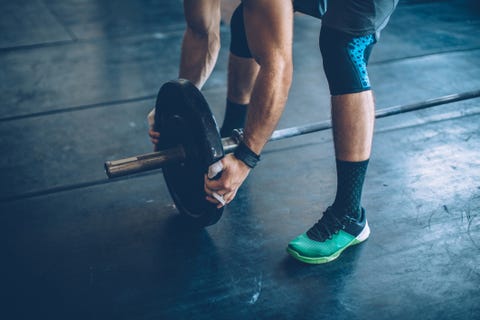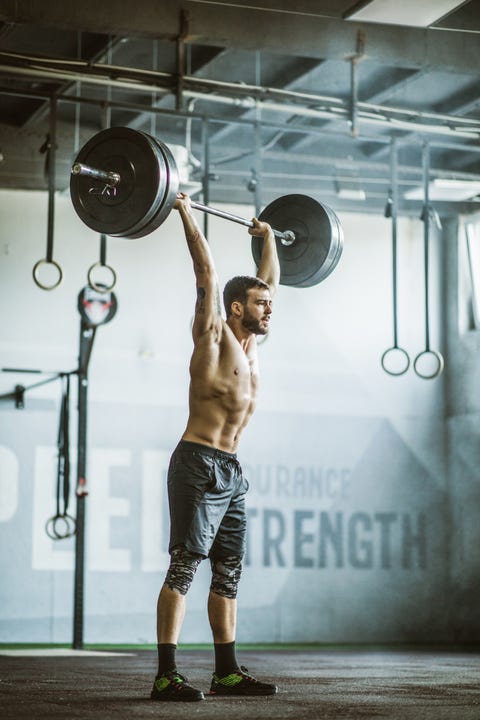The Daily Expert: Why Landmine Presses Can Save Your Shoulders from Injury

If you ask guys about the body parts they enjoy training most, shoulders and chest will usually rank near the top of the list. The downside of that: Ask guys the body parts that are most injured, and they’ll put shoulders near the top of that list, too.
It’s a true muscle-building conundrum: Some of the best shoulder- and chest-building exercises (think the military press and the bench press) are often the biggest offenders if you have shoulder issues. And shoulder injuries are myriad, everything from preexisting injuries, to imbalances to the surrounding muscles (think: Powerful chest but under-strengthened back), or poor shoulder mobility.
My solution to all that: The landmine press. Yes, people tend to think of the landmine as an ideal thing to use in leg training, but you can get a ton of mileage out of it for safe shoulder training. It’s a great way to work your shoulders and chest, but it’ll be easier on your joints than traditional barbell exercises. If you’re injured, that’s music to your ears, but even if you’re completely healthy, you can consider integrating landmine work into your training. Why not stay healthy, right?
Why the Landmine Press?
Getty Imagessvetikd
The landmine press is a great way to work your shoulders and chest in a way that much easier on the joints than traditional barbell exercises. Keep in mind, this isn’t just for injured folks; it’s great for anyone.
Setup is simple. Some gyms have a landmine attachment: Stick a barbell in there, and you’re ready to go. If your gym doesn’t have a landmine, just take a barbell and put it in the corner of your gym. (Make sure it’s a sturdy wall, though; the last thing you want is a hole in your gym wall.)
From there, all you need to do is choose the version of the landmine press that’s best for you. If you’re aiming for shoulder development, the single-arm landmine press is your best bet. It’s a lot like all those overhead pressing variations you’ve done, except with one key difference; it requires less shoulder flexion.
What’s Shoulder Flexion?
Getty Imagesskynesher
It’s basically the act of lifting your upper arm overhead. And most people think they can do it, because it seems natural, but if you watch how they get their arms overhead, you’ll see a lot of leaning and arching in their upper and lower back. Most guys lack the true shoulder mobility to do the overhead press.
The landmine press doesn’t force you to have truly perfect shoulder flexion, though, because of the position of the landmine. It’s a safe way to shoulder press. To do it, you simply grip the bar with one hand, standing in front of the landmine. Lower the head of the bar to your shoulder, then press it back up.
Different Presses for Different Muscle Goals
View this post on Instagram
A post shared by Karim Baylor (@karimperrybaylor) on
The standing version of this exercise is the ideal way for you to go, too. You can do it with your legs spread about shoulder-width apart, or you can use a staggered stance. To use the staggered stance, shift your right leg back if your right arm is holding the bar, and vice versa.
Either way, make sure to really brace your core and flex your abs. You’re focusing on your shoulders, obviously, but in many ways, this is also a full-body exercise, so you’ll want your core to keep you stable. You’ll need a tight core to avoid injury.
Think of doing 3 sets of 8 to 12 reps of this movement during your next shoulder workout.
There are other version of the move too, and that’s what people don’t always appreciate about the landmine press. You can easily make it an explosive “push press”. Start standing, arm extended overhead with the bar, then lower the bar to your shoulder. Keeping your core tight, bend your knees and hips a little bit, then explosively straighten them. Simultaneously shoot the bar upward so your arm is straight again.
View this post on Instagram
A post shared by Ben Bruno (@benbrunotraining) on
You can also integrate a little more ab work by using a half-kneeling or tall-kneeling stance. To use a half-kneeling stance, you’d bend your right knee to the ground if you’re holding the barbell in your right hand (or vice versa). Focus on keeping your hips and shoulders square as you press from this position.
There’s also the shoulder-to-shoulder press, which is best done from a tall kneeling position with a narrow stance. You’ll smoke your shoulders and hit a ton of core with this move, too.
View this post on Instagram
A post shared by Ben Bruno (@benbrunotraining) on
Finally, you can also involve your chest in this by doing a “bilateral” landmine press. Just interlock your hands together around the end of the barbell, then press straight up. This emulates an incline bench press or “squeeze” press, and it’ll smoke your chest. You can do this from either the standing, tall kneeling, or half-kneeling positions, again mixing in some core involvement.
It all adds up to one of the more underutilized tools in the gym. The landmine isn’t a gimmick in your gym; it’s a tool with a purpose, one that can save your shoulders and still give you a nasty workout, too.
Source: Read Full Article


